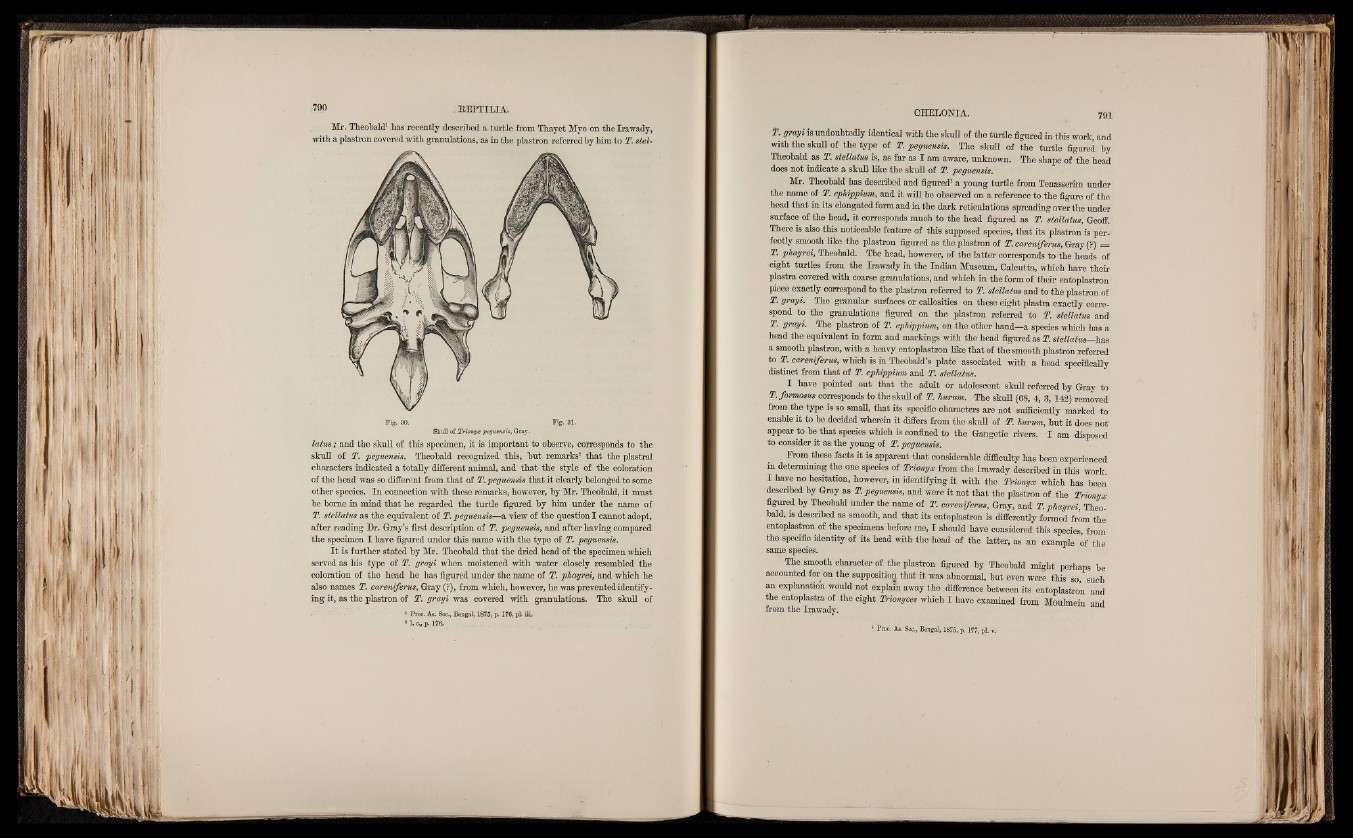
Mr. Theobald1 has recently described a turtle from Thayet Myo on the Ira wady,
with a plastron covered .with granulations, as in the plastron referred by him to T. stel-
Fig. 30. Fig. 31.
Skull of Trionyx peguensis, Gray. ,
latus ; and the skull of this specimen, it is important to observe, corresponds to the
skull of T. peguensis. Theobald recognized this, but remarks8 that the plastral
characters indicated a totally different animal, and that the style of the coloration
of the head was so different from that of T. peguensis that it clearly belonged to some
other species. In connection with these remarks, however, by Mr. Theobald, it must
be borne in mind that he regarded the turtle figured by him under the name of
T. stellatus as the equivalent of T. peguensis—a view of the question I cannot adopt,
after reading Dr. Gray’s first description of T. peguensis, and after having compared
the specimen I have figured under this name with the type of T. peguensis.
I t is further stated by Mr. Theobald that the dried head of the specimen which
served as his type of T. grayi when moistened with water closely resembled the
coloration of the head he has figured under the name of T. phayrei, and which he
also names T. careniferus, Gray (?), from which, however, he was prevented identifying
it, as the plastron of T. grayi was covered with granulations. The skull of
1 Proc. As. Soc.j Bengal, 1875, p. 176, pl> iii.
1 L o„ p. 176.
T. grayi is undoubtedly identical with the skull of the turtle figured in this work, and
with the skull of the type of T. peguensis. The skull of the turtle figured by
Theobald as T. 8tellatm is, as far as I am aware, unknown. The shape of the head
does not indicate a skull- like the skull of T. peguensis.
Mr. Theobald has described and figured1 a young turtle from Tenasserim under
the name of T. ephippium, and it will be observed on a reference to the figure of the
head that in its elongated form and in the dark reticulations spreading over the under
surface of the head, it corresponds much to the head figured as T. stellatus, Geoff.
There is also this noticeable feature of this supposed species, that its plastron is perfectly
smooth like the plastron figured as the plastron of T.earemferm,Gmg(f) ==
T. phayrei, Theobald. The head, however, of the latter corresponds to the heads of
eight turtles from the Irawady in the Indian Museum, Calcutta, which have their
piastra covered with coarse granulations, and which in thè form of their entoplastron
piece exactly correspond to the plastron referred to T. stellatus and to the plastron of
T. grayi. The granular surfaces or callosities on these eight piastra exactly correspond
to the granulations figured on the plastron referred to T. stellatus and
T. grayi. The plastron of T. ephippium, on the other hand—a species which has a
head the equivalent in form and markings with the head figured as T. stellatus has
a smooth plastron, with a heavy entoplastron like that of the smooth plastron referred
to T. careniferus, which is in Theobald’s plate associated with a head specifically
distinct from that of T. ephippium and T. stellatus.
I have pointed out that the adult or adolescent skull referred by Gray ■ to
T.formosus corresponds to the skull of T. hmrum. The skull (68, 4, 3,142) removed
from the type is so small, that its specific characters are not sufficiently marked to
enable it to be decided wherein it differs from the skull of T. hurum, but it does not~
appear to be that species which is confined to the Gangetic rivers. I am disposed
to consider it as the young of T. peguensis.
Thom these facts it is apparent that considerable difficulty has been experienced
in determining the one species of Trionyx from the Irawady described in this work.
I have no hesitation, however, in identifying-it with the Trionyx which has been
described by Gray as T. peguensis, and were it not that the plastron of the Trionyx
figured by Theobald under the name of T. careniferus, Gray, and T. phayrei, Theobald,
is desoribed as smooth, and that its entoplastron is differently formed from the
entoplastron of the specimens before me, I should have considered this sped®, from
the specific identity of its head with the head of the latter, as an example of the
same species.
The smooth character of the plastron figured by Theobald might perhaps be
accounted for on the supposition that it was abnormal, but even were this so, such
an explanation would not explain away the difference between its entoplastron and
the entoplastra of the eight Trmnyces whioh I have examined from Moulmein and
from the Irawady.
1 Proc. As. Soc., Bengal, 1875, p. 177, pi. v.